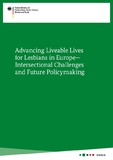| dc.description.abstract | This research report has been commissioned
by the German Federal Ministry for Family
Affairs, Senior Citizens, Women and Youth
(BMFSFJ). This report assesses the need for a
specific focus on lesbians in European equality
and anti-discrimination policies.1
The use of
lesbian, gay, bisexual and transgender (LGBT) as
a policy category has been criticised for lumping
together diverse life realities. The call to focus on
lesbians can be read as a response to the gender
indifference and erasure of lesbians from LGBT
policy debates.
Lesbian lives in Europe are highly diverse. The
term lesbian is a contested political and social
category. As an identity, it is most commonly
claimed by women who desire other women. This
departure from the heterosexual norm exposes
lesbians to marginalisation and discrimination.
However, not all lesbians identify with the category woman. For many lesbians, the category
woman is a source of gender stereotypes. Certain
lesbians break with norms of feminine gender
presentation. Others claim alternative terms to
consolidate their sexual identities with their
gender identity, for example, by identifying as
butch lesbians, genderqueer or non-binary
lesbians, trans*2
lesbians or femme lesbians. Nonetheless, in policy and academic discourses,
the term sexual orientation is often used without
paying attention to gender. Academically, the category lesbian has therefore been deemed helpful
in naming and describing how heteropatriarchal
norms affect women (Banerjea et al., 2019; Butler,
1993; Boulila, 2015). The category lesbian renders
visible the specific effects homophobia, heterosexism and heteronormativity have on women and
those who identify as lesbians but not as women.
The term lesbian, therefore, captures specific experiences of discrimination, disenfranchisement and
violence.
This report queries how European equality and
anti-discrimination policies can better account
for the needs of lesbian women. Besides understanding lesbian as a contested and heterogeneous category, this report understands the
category woman as inter*- and trans*-inclusive.
In order to reveal this inclusivity in addition to
marking many lesbians’ suspicion towards the
category woman, the term will be marked with
an asterisk (woman*). Due to the study’s limited
time frame, this report will not be able to provide
an in-depth exploration of the specific challenges
faced by trans* and intersex lesbians. Neither will
it be able to examine the specific challenges of bisexual women*. However, it does aim to uncover issues that are relevant to bisexual, trans* and
intersex women* where possible. In instances
where issues affect lesbian, bisexual, trans* and
intersex women* (LBTI women*), the report will
make these different groups visible through a
nuanced use of language.
The report commonly refers to the term heteronormativity, which critiques the assumption that
heterosexuality is the primary, natural and normal
expression of sexuality. It further uses the term
homophobia to refer to anti-gay hostility. The report does not use the term in its psychological
connotation to refer to fear, as this has been criticised as individualising (Browne et al., 2015;
Boulila, 2019b). Heteronormativity and homophobia are instead understood to be connected to
each other and an expression of social power
relations. This report evaluates the need for specific equality
and anti-discrimination policies that focus on
lesbians. Chapter two describes the methodology
that was used to identify the intersectional needs
of lesbians in Europe. Chapter three, ‘Lesbian
rights under EU law’, authored by Alina Tryfonidou, explores the legal framework for LGBT and
in particular lesbian rights. It examines European
Union (EU) provisions, instruments and European
Court of Justice (ECJ) rulings that benefit lesbians.
Chapter four unfolds in twelve thematic subsections that illustrate not only specific inequalities
faced by lesbians but also relevant policy areas, institutions, strategies and best practice examples.
Chapter five explores convergences and divergences between European and national equality
and anti-discrimination policies. These convergences and divergences further provide insight
into national policymaking and draw attention
to the situated challenges of lesbians in Poland,
Sweden, Greece and Germany. Chapter six closes
with a summary and policy recommendations. | en_UK |


